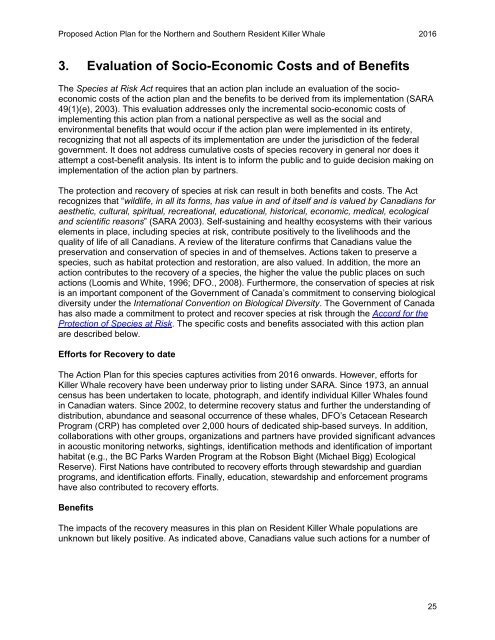Resident Killer Whale
Ap-KillerWhale-v00-2016Jun13-Eng
Ap-KillerWhale-v00-2016Jun13-Eng
Create successful ePaper yourself
Turn your PDF publications into a flip-book with our unique Google optimized e-Paper software.
Proposed Action Plan for the Northern and Southern <strong>Resident</strong> <strong>Killer</strong> <strong>Whale</strong> 2016<br />
3. Evaluation of Socio-Economic Costs and of Benefits<br />
The Species at Risk Act requires that an action plan include an evaluation of the socioeconomic<br />
costs of the action plan and the benefits to be derived from its implementation (SARA<br />
49(1)(e), 2003). This evaluation addresses only the incremental socio-economic costs of<br />
implementing this action plan from a national perspective as well as the social and<br />
environmental benefits that would occur if the action plan were implemented in its entirety,<br />
recognizing that not all aspects of its implementation are under the jurisdiction of the federal<br />
government. It does not address cumulative costs of species recovery in general nor does it<br />
attempt a cost-benefit analysis. Its intent is to inform the public and to guide decision making on<br />
implementation of the action plan by partners.<br />
The protection and recovery of species at risk can result in both benefits and costs. The Act<br />
recognizes that “wildlife, in all its forms, has value in and of itself and is valued by Canadians for<br />
aesthetic, cultural, spiritual, recreational, educational, historical, economic, medical, ecological<br />
and scientific reasons” (SARA 2003). Self-sustaining and healthy ecosystems with their various<br />
elements in place, including species at risk, contribute positively to the livelihoods and the<br />
quality of life of all Canadians. A review of the literature confirms that Canadians value the<br />
preservation and conservation of species in and of themselves. Actions taken to preserve a<br />
species, such as habitat protection and restoration, are also valued. In addition, the more an<br />
action contributes to the recovery of a species, the higher the value the public places on such<br />
actions (Loomis and White, 1996; DFO., 2008). Furthermore, the conservation of species at risk<br />
is an important component of the Government of Canada’s commitment to conserving biological<br />
diversity under the International Convention on Biological Diversity. The Government of Canada<br />
has also made a commitment to protect and recover species at risk through the Accord for the<br />
Protection of Species at Risk. The specific costs and benefits associated with this action plan<br />
are described below.<br />
Efforts for Recovery to date<br />
The Action Plan for this species captures activities from 2016 onwards. However, efforts for<br />
<strong>Killer</strong> <strong>Whale</strong> recovery have been underway prior to listing under SARA. Since 1973, an annual<br />
census has been undertaken to locate, photograph, and identify individual <strong>Killer</strong> <strong>Whale</strong>s found<br />
in Canadian waters. Since 2002, to determine recovery status and further the understanding of<br />
distribution, abundance and seasonal occurrence of these whales, DFO’s Cetacean Research<br />
Program (CRP) has completed over 2,000 hours of dedicated ship-based surveys. In addition,<br />
collaborations with other groups, organizations and partners have provided significant advances<br />
in acoustic monitoring networks, sightings, identification methods and identification of important<br />
habitat (e.g., the BC Parks Warden Program at the Robson Bight (Michael Bigg) Ecological<br />
Reserve). First Nations have contributed to recovery efforts through stewardship and guardian<br />
programs, and identification efforts. Finally, education, stewardship and enforcement programs<br />
have also contributed to recovery efforts.<br />
Benefits<br />
The impacts of the recovery measures in this plan on <strong>Resident</strong> <strong>Killer</strong> <strong>Whale</strong> populations are<br />
unknown but likely positive. As indicated above, Canadians value such actions for a number of<br />
25


